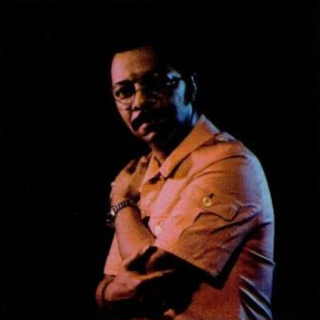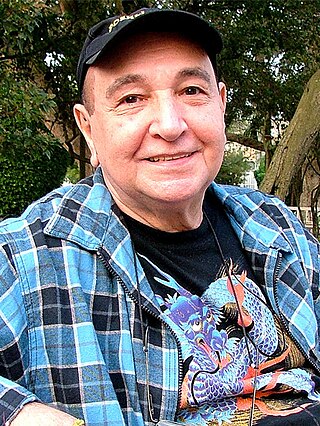Related Research Articles
Jerome Richardson was an American jazz musician and woodwind player. He is cited as playing one of the earliest jazz flute recordings with his work on the 1949 Quincy Jones arranged song "Kingfish".

Callen Radcliffe Tjader Jr. was an American Latin Jazz musician, often described as the most successful non-Latino Latin musician. He explored other jazz idioms, especially small group modern jazz, even as he continued to perform music of Africa, the Caribbean and Latin America.

Al McKibbon was an American jazz double bassist, known for his work in bop, hard bop, and Latin jazz.

Grady Tate was an American jazz and soul-jazz drummer and baritone vocalist. In addition to his work as sideman, Tate released many albums as leader and lent his voice to songs in the animated Schoolhouse Rock! series. He received two Grammy nominations.

Edgar Gómez is a Puerto Rican jazz double bassist, known for his work with the Bill Evans Trio from 1966 to 1977.

Airto Guimorvan Moreira is a Brazilian jazz drummer and percussionist. He is married to jazz singer Flora Purim, and their daughter Diana Moreira is also a singer. Coming to prominence in the late 1960s as a member of the Brazilian ensemble Quarteto Novo, he moved to the United States and worked in jazz fusion with Miles Davis, Return to Forever, Weather Report and Santana.

Juvenal de Holanda Vasconcelos, known as Naná Vasconcelos, was a Brazilian percussionist, vocalist and berimbau player, notable for his work as a solo artist on over two dozen albums, and as a backing musician with Pat Metheny, Don Cherry, Jan Garbarek, Egberto Gismonti, Gato Barbieri, and Milton Nascimento.

William Correa, better known by his stage name Willie Bobo, was an American Latin jazz percussionist of Puerto Rican descent. Bobo rejected the stereotypical expectations of Latino music and was noted for his versatility as an authentic Latin percussionist as well as a jazz drummer easily moving stylistically from jazz, Latin and rhythm and blues music.
"Manhã de Carnaval", often referred to as "Black Orpheus", is a song by Brazilian composer Luiz Bonfá and lyricist Antônio Maria.
James Elbert Raney was an American jazz guitarist, born in Louisville, Kentucky, United States, known for his work from 1951 to 1952 and then from 1953 to 1954 with the Red Norvo trio and, during the same time period, with Stan Getz. In 1954 and 1955, he won the DownBeat Critics' Poll for guitar. Raney worked in a variety of jazz mediums, including cool jazz, bebop, post bop, hard bop, and mainstream jazz.
Don Kiethly Butterfield was an American jazz and classical tuba player.

Harold Vick was an American jazz saxophonist and flautist.
Seldon Powell was an American soul jazz, swing, and R&B tenor saxophonist and flautist born in Lawrenceville, Virginia.

João Donato de Oliveira Neto was a Brazilian jazz and bossa nova pianist as well as a trombonist from Rio Branco. He first worked with Altamiro Carrilho and went on to perform with Antonio Carlos Jobim and Astrud Gilberto. Because of the area he grew up in Brasil he was able to hear Cuban music on the radio. This influence would manifest itself in many of his compositions, piano, and trombone playing. Donato's most well-known compositions include: "Amazonas", "Lugar Comum", "Simples Carinho", "Até Quem Sabe" and "Nasci Para Bailar".

John Payne Guerin was an American percussionist. He was a proponent of the jazz-rock style.
Milton Holland was an American drummer, percussionist, ethnomusicologist and writer in the Los Angeles music scene. He pioneered the use of African, South American, and Indian percussion styles in jazz, pop and film music, traveling extensively in those regions to collect instruments and learn styles of playing them.
Jerry Dodgion was an American jazz saxophonist and flautist.
Robert Northern, known professionally as Brother Ah, was an American jazz French hornist.
Oscar Brashear was an American jazz trumpeter and session musician from Chicago, Illinois.
George Roland Bohanon, Jr. is a jazz trombonist and session musician from Detroit, Michigan.
References
- 1 2 Feather, Leonard (ed.) (2007). "Correa, Mayuto (Mailto)". The Biographical Encyclopedia of Jazz. Oxford University Press. ISBN 0199729077
- 1 2 Dicionário Cravo Albin da Música Popular Brasileira. "Mayuto Correa". Instituto Cultural Cravo Albi. Retrieved 28 July 2016 (in Portuguese).
- ↑ Feather, Leonard (24 July 1977). "Mayuto Blows the Whistle on Big Bucks". Los Angeles Times . Retrieved 28 July 2016.
- ↑ Down Beat (1982). Volume 49, p. 54
- ↑ OCLC 73994616
- ↑ Eirado, Andrea (July 2006). "Mayuto Correa, Talented and Creative". Brazil Explore, p. 35. Retrieved 28 July 2016.
- ↑ Tucker, Darla Martin (21 March 2015). "World-renowned percussionist Mayuto Correa to play Pierce Street Jazz series", La Sierra University. Retrieved 28 July 2016.
- ↑ Redeemed at IMDb
- ↑ Community at IMDb
- ↑ "Mayuto Correa". Discogs. Retrieved 14 July 2017.
- ↑ OCLC 593831454